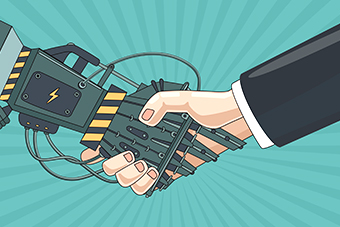It was the ‘knight sacrifice’ that wrecked Garry Kasparov’s defence in 1997, sending the world chess champion into a crash-and-burn tailspin within the first twenty moves of the game. Unlike his competitor, the victor did not move his piece with unsteady hand on the board. His heart didn't pound within his chest; he wasn’t biting his lip with uncertainty. This 32-node, 256-processor wasn't even capable of blinking an eye; he just won fair and square. ‘Deep Blue’ was never programmed to celebrate, so the tears of victory were saved for some rather elated IBM inventors on the sidelines.
This showdown of man vs machine (man 0, machine 1) was hugely symbolic, proving that artificial intelligence was catching up with the power of the human mind. A computer had successfully defeated a human champion, in a domain in which mastery was previously seen as the pinnacle of human intelligence.
Fast forward to today, and a chess program running on a standard cell phone can beat a human grandmaster; we can conduct business meetings in Mandarin (without knowing a single word of it), and computers’ original poetry can give Emily Dickinson a run for her money.
Given the pace of the digital revolution and how it’s transforming the economy and employment opportunities: The question on everyone’s lips now, is “When will humans be obsolete?” The truth is machines don’t need to be perfect to make their way into society. They just need to be better (and cheaper) than humans.
Autonomous vehicles are a good example of this. There are 1.25 million road-related deaths annually in the world each year. Google’s cars have driven more than 1.3 million miles since 2009, with only one official ‘incident’. The reality is that machines are already better at doing so many things that humans do… just ask Garry Kasparov.
But business theorists Erik Brynjolfsson and Andrew McAfee tell us to stay very optimistic about technological progress. Their book, The Second Machine Age, spotlights the dynamic forces shaping our lives today; and the unprecedented opportunities these present.
Here are the some of the big ideas:
Growth is a good thing
The new machine age has three driving factors.
 Firstly, it is digital. This essentially means that when something is done right, it can be instantly replicated at a higher quality than a human would be able to, with zero cost. It can also be measured. And measurement is the lifeline of science and progress. In the age of big data, we can measure the world in ways we never could before.
Firstly, it is digital. This essentially means that when something is done right, it can be instantly replicated at a higher quality than a human would be able to, with zero cost. It can also be measured. And measurement is the lifeline of science and progress. In the age of big data, we can measure the world in ways we never could before.
Secondly, it is exponential. Computers get better faster than anything else, ever. A child's PlayStation today is more powerful than a military supercomputer from 1996. Unlike the human brain that is wired for a linear world, digital systems innovate at frighteningly complex speeds and levels. This means that vital information – empowering tools – are at your fingertips.
And thirdly, it is combinatorial. Successful innovation creates building blocks for even more innovations, leaving limitless room for positive progress.
Together, these driving factors have the potential to drive forward (as opposed to displace) many professions. Take, for example, the medical profession. By applying an algorithm inspired by the human brain, known as deep learning, doctors have now developed a machine learning-based system that more accurately predicts survival rates for cancer sufferers than human pathologists could.
Even more so, the digital system has generated helpful groundbreaking discoveries in pathology. Data analytic techniques now generate complex diagnostic information in less than 15 minutes, speeding up the process of pinpointing the problems and allowing the doctor to do what they do best – treat it!
Destiny has skin
It’s understandable to be skeptical, even scared, of the imminent digital landscape. But let’s remember: Technology is not destiny; we shape our destiny. Writer Oscar Schwartz says technology is best described as a mirror to the human imagination. “We should not only be asking ourselves, ‘can we build it?’ But we should also be asking ourselves, ‘What idea of the human do we want to have reflected back to us?’”
Let’s race with the machine, not against it
There’s no wisdom in racing against the machine, especially when there’s so much combustive potential lurking in human synergy. The key is to tap into the shared prosperity of a man-and-computer symbiosis.
Today a supercomputer no longer holds the reigning title for chess. Neither does a man. Rather, teams of humans and computers work together to build something that is greater than the sum of its parts – i.e. an intelligent computer capable of synergising the best human performances and amplifying this to go on to supersede what humans (or arguably computers) would be able to achieve on their own.
There’s no grandmaster winner at the end; nor is there a victorious supercomputer. What there is, however, is better teamwork, proving that human and technological collaboration is not only optimal; it’s essential for the human story.
This blog was authored by: John Hainsworth




